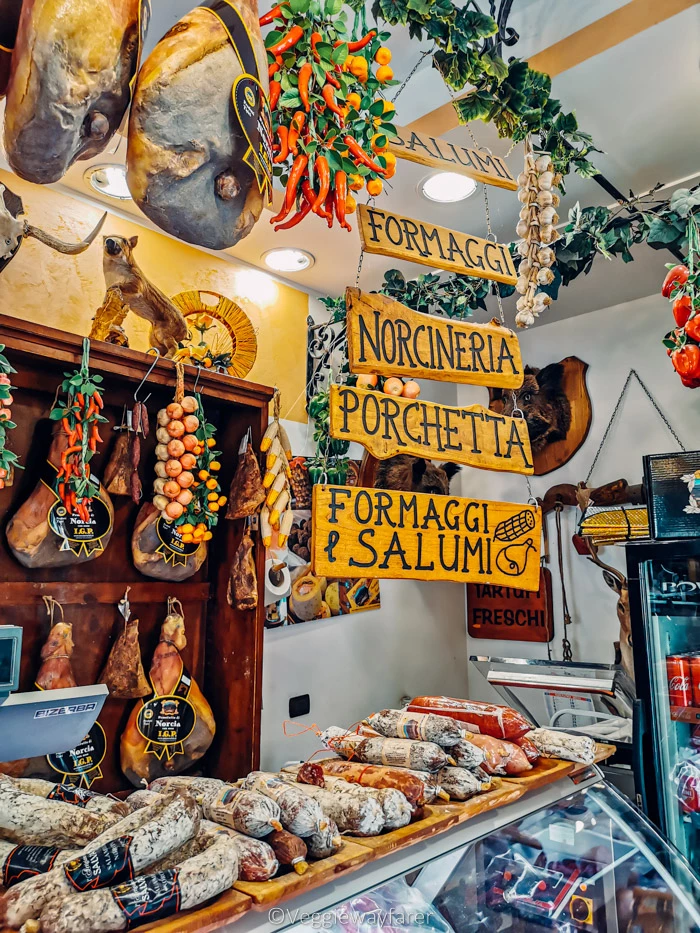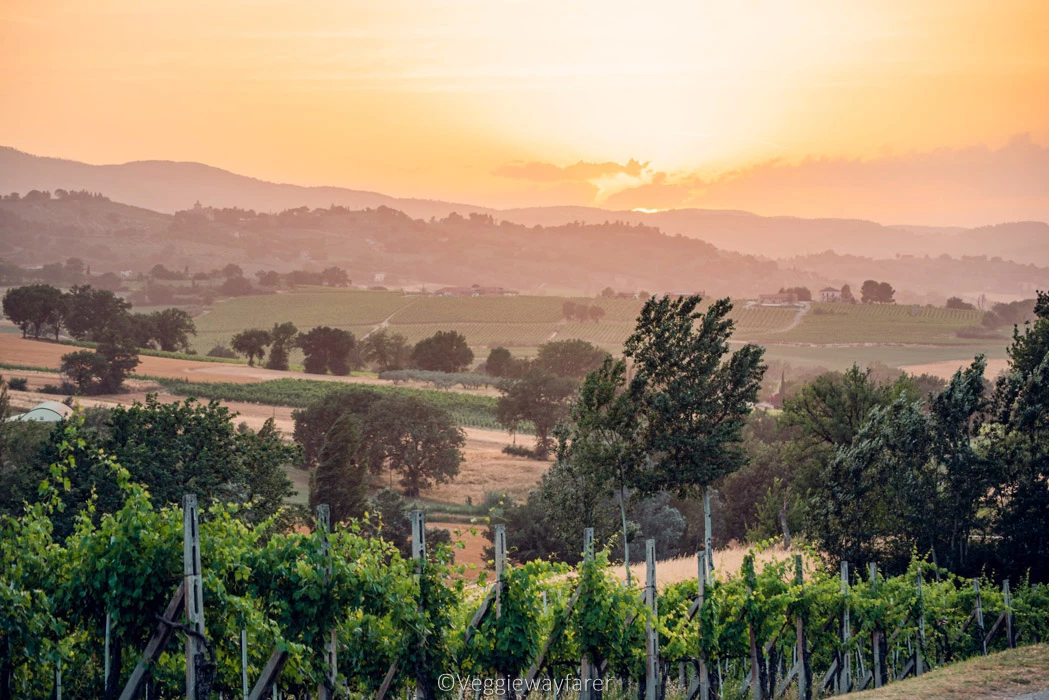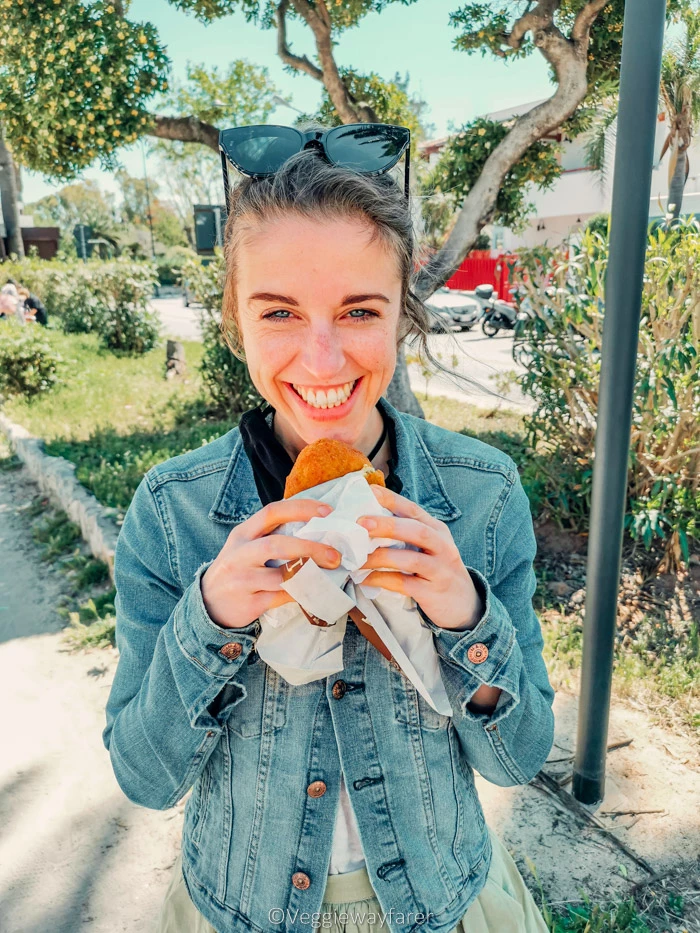The region of Umbria has some truly spectacular cuisine: Truffles, lentils, focaccias (and admittedly a lot of pig-derived charcuterie and meat) are real specialties of this marvelous region in the heart of Italy. So come with me and let’s dig into this authentic treasure trove that is Umbrian food!
Rolling hills dotted by castles and olive fields, beautiful castles, and amazing medieval villages. If you’re thinking about Tuscany, allow me to let you in on a secret: Umbria has all of the above in the same quality as its more famous neighbor and minus the hordes of tourists!
This food guide will run through both vegetarian and non-vegetarian specialties of Umbrian cuisine as well as give you a little insight into where the origins of the various dishes that are famous in this lesser-known province of central Italy.
Please note: This post contains affiliate links, meaning I may earn a commission if you make a purchase by clicking a link (at no extra cost to you). Learn more.


Best tours to explore Umbrian food
There is no better way to get a deep understanding of Umbrian cuisine than by simply trying it. Long lunches, leisurely dinners, and plenty of snacks in between are part and parcel of a visit to this region.
When we traveled to Umbria, locals passionately imparted their knowledge of the various regional specialties and typical wines we had to try. This passion is also what drives many of the locally-led food tours and makes them great fun!

TOUR FOR WINE LOVERS: Umbria Wine Lovers Tour
Visit three traditional cellars to sample delicious Umbrian wines such as Sagrantino Montefalco DOCG and Montefalco Rosso, during informal guided tastings led by winemakers. Includes a delicious lunch with organic Umbrian specialties to be washed down with ample amounts of local Umbrian wine.

TOP FOODIE TOUR IN PERUGIA: Taste Perugia Local Food Tour
Eat your way around Perugia’s historical center in a 4-hour food tour. Taste more than 10 + regional foods from locally run restaurants, quaint cafes and artisanal shops dotted around Perugia. Learn about the city through the eyes of a local and end the day in one of Italy’s top gelaterias.

VALUE FOR MONEY TOUR: Assisi Wine Tasting Picnic
Have a picnic in a family-run vineyard in the shadow of the Basilica of Saint Francis Assisi. This 2.5-hour tour takes you through the vineyards and teaches you all about Umbrian wines and olive oil. Enjoy a delicious picnic filled with typical Umbrian delicacies (Torta al Testo, Perugian bread, cured meats and cheeses, and delicious Umbrian cookies) right in the heart of the vineyard.
Unmissable Food in Umbria:
12 traditional Umbrian dishes to try
Discovering Umbrian cuisine was a real highlight of my road trip through Umbria. No matter the size of the restaurant (from a tiny little hole in the wall to well-established) the food was, without fault, always delicious.
These 12 dishes are some of the region’s finest and a must-try for any self-respecting foodie!

Vegetarian-friendly food in Umbria

While it is true that the region is known for charcuterie and the concept of vegetarianism might seem a little strange to locals, rest assured you will not go hungry in Umbria as a vegetarian. Food in Umbria is focused on fresh, locally sourced ingredients which – thanks to the talent of local chefs – can be transformed into a finger-licking vegetarian meal in no time.
Below 5 dishes are usually a safe bet to try as a vegetarian, but just to be sure always make sure to ask if the dishes are vegetariano (vegetarian).
More Italian Food: To give you a few extra options, read up on these vegetarian dishes in Italy
that are not typically Umbrian but can be found in most local restaurants.

Arvortolo
The Arvortolo is a type of fried pizza typical for the region of Perugia, most commonly eaten during the traditional village feasts. The name means flipped in the local dialect, as the pizza is flipped continuously on either side to ensure proper cooking. What is this fried pizza made of?
Nothing could be simpler: Flour, oil, and salt. This traditional Umbrian food also exists in a sweet version, in which salt is substituted by sugar.
Get Cooking: Learn more about traditional Umbrian cuisine in a hands-on half-day cooking class in the city of Perugia. This top-rated class teaches you 4 recipes and provides plenty of Umbrian wine to sample. Check availability

Bandiera
Bandiera means flag in Italian and if you’re familiar with the Italian national flag (Il tricolore) you’ll understand why this traditional side dish is called so: Green bell peppers, onions, and tomatoes make up this not exactly light recipe.
This patriotic referral notwithstanding, the Bandiera’s origins are forgotten in the midst of history: As is the case for most of the food in Umbria, this dish is in fact extremely old. Back in the day farmers would put together the ingredients of their orchard on top of hardened bread (a sort of old-style bruschetta), to this day the dish is still best enjoyed with a side of bread.

Farrecchiata di roveja
The difficult name of this recipe needs to be broken down in two to better explain this dish. Farrecchiata is a method of preparation, in which a legume or a grain gets dusted with flour and then cooked as Polenta.
Roveja, on the other end, is the name of one of the typical legumes – belonging to the family of peas – from Umbria and in fact, can only be found in this region and in the neighboring region of Marche. The Farrecchiata di roveja is basically polenta with peas, just better! The cook adds a stir-fry of oil, garlic, anchovies, and sage to the polenta & pea mix.
Let me tell you when these get mixed together, it’s a real feast! If there is one traditional vegetarian Umbrian food you need to try on your this, let it be this one!

Torta al testo
Torta al testo is the traditional focaccia from Umbria, which can be found throughout the region. When I say traditional, I mean it: testo is the name of the stone plate used by the Ancient Romans upon which focaccia was cooked.
It comes in many different varieties, but the favorites of most locals remain the traditional one: local ham (Prosciutto di Norcia) and local cheese (Pecorino Umbro). Fret not, this dish can easily be transformed into a delicious vegetarian alternative by simply replacing the prosciutto.
Ask for a vegetarian alternative to this traditional Umbrian food in any location that sells Torta al testo and they will be happy to oblige!

Impastoiata
Impastare in Italian means to knead and indeed there is a lot of kneading in this age-old Umbrian food! Traditional and with a long agricultural history, as is the case for many of the dishes in this list: This mix of Polenta and Borlotti beans was, in fact, one of the many ways that farmers used to address their chronic lack of meat.
Thankfully for us, their ingenuity gave us a delicious, healthy, and nutrient winter recipe that will warm everyone’s heart!

Meat-based Umbrian food

Umbrian cuisine is widely known for its farm-to-table approach when it comes to its ingredients, especially meat. Meat is either cooked in traditional dishes or transformed into delicate charcuterie which is the perfect accompaniment to a glass of nice Umbrian wine.
As a vegetarian myself, I cannot personally attest to the taste of the below dishes. Therefore I asked my partner to be my official taste tester and ensure only the very best made it on the list.

Pasta alla Norcina
It would be impossible to write a guide on food in Umbria without mentioning the ever-present Pasta alla Norcina. This joy for the (carnivorous) palate is made with a sauce of onion, garlic, pork sausage, ricotta cheese, black pepper, and local black truffle. It is the quintessential plate of Norcia, which is renowned for its Norcinerie (shops focused on pork-based charcuterie) and truffles.
Walking through the little town – unfortunately very much still destroyed by the 2016 earthquake – you’ll encounter dozens of them, a real risk for your wallet!


Photo courtesy of Paola via wikicommons
Strangozzi
This a rather simple one, but a list of Italian dishes without mentioning a typical pasta shape would not be complete! Strangozzi is a pasta from Spoleto, similar to tagliatelle, and almost exclusively freshly prepared. To get a true feel of food in Umbria, order strangozzi with either truffle from Norcia (Umbria is famous in all of Italy for its truffles) or with the Norcina sauce.

Friccò all’eugubina
The names of this typical winter plate are difficult to understand, even for an Italian, therefore it deserves an explanation, actually two. Fricco’ could either come from Latin or French and it refers to the different manners of cooking meat.
Eugubina means from Gubbio the foremost example of a medieval city in Umbria and a must-see on every trip through this beautiful region. So in short, this traditional Umbrian food is a stew of white meat (normally either lamb or rabbit) both stewed and seared served with potatoes and vegetables and sprinkled with the ever-present aromatic herbs. Nothing better to withstand the cold winters in the Umbrian hills!
Foodie Tip: If you are staying in Gubbio, be sure to check out their locally run street food tour. Try some typical food staples from Gubbio and bring food souvenirs back from trusted artisanal food shops. Check availabilities


Crostini alla spoletina
Food in Umbria was traditionally not only absolutely delicious, it also served an important purpose of providing energy for the populous. A prime example of this can be found in the Crostini alla spoletina.
Spoleto is one of the most beautiful towns in Umbria, with a stunning castle overlooking the entire medieval city and its valley. The city is built on a vertical axis, with plenty of steps and steep streets.
Walking up and down was a very tiring affair, it goes without saying that the inhabitant needed a filling meal to replenish their energy – cue Crostini alla spoletina: Grilled bread with black truffle, anchovies, garlic, olive oil, lemon juice.
The unusual combination of the strong flavors of both the truffle and the anchovies makes for a rather unique but delicious taste and – trust me – it is addictive!

Not to be missed while trying Umbrian food: Desserts

Italy sure loves its desserts and Umbria most certainly does the country proud! You will want to save some room to dry the typical Umbrian desserts.

Torcolo di San Costanzo
This typical dessert from Perugia is traditionally prepared for the day of Perugia’s patron-saint, Saint Costanzo on January 29th and has a long list of popular tales linked to its origins: One story says the shape refers to the beheaded neck of Saint Costanzo, others link it to the gems-laced necklace the saint used to wear, others still say – in a more prosaic fashion – state that its hole was simply used to hang the dessert during the city’s celebrations.
Regardless of the origins of this Umbrian food, what is sure is that this dessert was donated to Perugia’s single girls who used to go pray in front of Saint Costanzo’s image hoping the image would wink back at them – a sure sign of an impending wedding.
If the statue wasn’t inclined to perform this less-than-ordinary gesture, the girls would receive the dessert as a consolation prize. Now, let’s dig into its actual composition: The Torcolo di San Costanzo has its origin in popular cuisine, hence it’s humble – but delicious! – ingredients: Water, flour, lard, sugar, and sweets like raisins, pine seeds, and anise. Its shape (hence the name Torcolo) is one of rolled dough.

Crescionda
From Perugia to wonderful Spoleto, the city of flowers. From a religious celebration to a pagan one, Crescionda is in fact typically prepared for Carnival. This dish dates back to the middle ages and does not have just one single official recipe.
As with much of the food in Umbria, the dish has at least 3 recipes: A three-layered one (amaretti and flour, egg-based cream, chocolate), a lighter recipe containing apples, and the Poretta, lemon-based recipe.
Regardless of the version, there are a few common ingredients: Anise liquor, rum, lemon zest, vanilla, and cinnamon. A real delicacy, worthy of Carnival’s extravaganza!
Explore more typical dishes from Spoleto: Visit artisanal food shops & sample traditional delicacies from Spoleto in a small-size immersive culinary experience. Check availabilities.

Rocciata
The Rocciata is a typical sweet delicatessen from Assisi – the city of San Francis – which might remind you of the Austrian-Slovenian Strudel, due to its rolled shape. This shape of this typical Umbrian dessert carries the secret to its name: The word roccia in the local dialect means “rolled”.
The Rocciata’s dough is very thin, with a crunchy texture, stuffed with a filling that is made from a delectable mixture of walnut, apples, and dried fruit. To top it off, the dessert has a characteristic red hue, which it thanks to the light glazing of Alchermes (an Italian liquor used mainly in dessert and made of alcohol, sugar, water, cloves cinnamon, cardamom, raspberry, rosewater, and red colorant). Enjoy!
Umbrian food in a nutshell
I hope that this small culinary journey through the specialties of Umbrian Food has inspired you to visit the region. Its restaurants alone are worth a visit, even if without considering its architectural beauty and its breath-taking landscape. When you pair these together, you’ll find yourself wondering why tourists don’t flock in droves to Umbria. And, more importantly, why you didn’t visit before this – still relatively unexplored – gem.
So pack up, ignore your jeans’ threats about not fitting anymore and come indulge in the slow, beautiful pleasure that Umbria has to offer. Italian food is some of the tastiest food available, and any restaurant you go to whether it’s in Italy or, perhaps more local to home, you might find yourself falling in love with a new dish.

MORE TRAVEL RESOURCES FOR ITALY
Traveling Northern Italy one to two-week itinerary
Where to stay in the Dolomites
The perfect accommodation guide for Sicily

Traditional Umbrian Food Guide: Pin it










0 Comments